You are using an out of date browser. It may not display this or other websites correctly.
You should upgrade or use an alternative browser.
You should upgrade or use an alternative browser.
Tyrannosaurus rex maquette
- Thread starter Scar
- Start date

Help Support Collector Freaks Forum:
This site may earn a commission from merchant affiliate
links, including eBay, Amazon, and others.
Dyscrasia
Super Freak
I received my T. rex maquette finally!!!
It's a real beauty, and the even though the overall color tone is slightly darker compared to the prototype, it still rules nonetheless.
On the other hand, I was informed that my Carnotaurus maquette will arrive sometime late in November or early Decemeber
I wonder how much I'll have to wait to receive the Styracosaurus maquette and Deinosuchus vs. Parasaurolophus dio....
It's a real beauty, and the even though the overall color tone is slightly darker compared to the prototype, it still rules nonetheless.
On the other hand, I was informed that my Carnotaurus maquette will arrive sometime late in November or early Decemeber
I wonder how much I'll have to wait to receive the Styracosaurus maquette and Deinosuchus vs. Parasaurolophus dio....
Last edited:
Reinhardt
Super Freak
Brilliant pics!!
Just got mine yesterday as well. Will try to post pics in the next week or so. Overall, I love it and actually like it more than the Carnotaurus. Love the paint coloring, the pose and the base. Mine has a few minor chips on the left leg, but nothing a bit of paint can't fix. Also, it looks like this left nostril has a booger - can't weird, but nothing major. And yes, like other people have mentioned, the paint job on the scaring is not great - I might have that redone as well.
I was just staring it at last night and had the huge smile on my face. The detail on this thing is staggering. And it is a great size. Not too big, and definitely not too small.
Just got mine yesterday as well. Will try to post pics in the next week or so. Overall, I love it and actually like it more than the Carnotaurus. Love the paint coloring, the pose and the base. Mine has a few minor chips on the left leg, but nothing a bit of paint can't fix. Also, it looks like this left nostril has a booger - can't weird, but nothing major. And yes, like other people have mentioned, the paint job on the scaring is not great - I might have that redone as well.
I was just staring it at last night and had the huge smile on my face. The detail on this thing is staggering. And it is a great size. Not too big, and definitely not too small.
Yes, the scarring definitely doesn't live up to the standard set by the rest of the piece. They're just odd-looking: not only is the color peculiar, they just don't look real, or - when you look how the wounds would've been inflicted - even plausible (give me a break, I studied to be a forensic anthropologist and a crime scene investigator. I know what injuries look like!  )
)
(Another very minor critique: Making the last third of the rex's tail so seemingly flexible (see pics, he has it twirling like a cat) is questionable in my mind. I'm not the expert Scar is (and I'd appreciate it if he weighed in on this), but I do know a little about dinos and my impression is that theropod tails were pretty rigid.)
But the idea of having a scarred old bull rex is a neat one, and fortunately it's easy to look past niggles about blah scars when looking at virtually every other part of the piece. The eyes are great, the profile is great, I personally prefer the color in the production model to the prototype. The paint on the teeth is fantastic - funnily enough, looking at photos of my own piece helped me appreciate that. And the sculpt is really remarkable, I mean it looks... well, it looks like something you spent a couple hundred bucks on! And that's nice, because as fellow collectors you know you can't always say that!
I have 4 big bookshelves in my office, and spread among them surely a dozen or more dinosaur books. I'm loving seeing the rex on top of one and the carnotaurus on top of the other - and in a few months, a styracosaur on the third!
Bring on a quetzalcoatus, dilophosaurus and/or a pachycephalosaurs, Sideshow! I can buy more bookshelves!
(Another very minor critique: Making the last third of the rex's tail so seemingly flexible (see pics, he has it twirling like a cat) is questionable in my mind. I'm not the expert Scar is (and I'd appreciate it if he weighed in on this), but I do know a little about dinos and my impression is that theropod tails were pretty rigid.)
But the idea of having a scarred old bull rex is a neat one, and fortunately it's easy to look past niggles about blah scars when looking at virtually every other part of the piece. The eyes are great, the profile is great, I personally prefer the color in the production model to the prototype. The paint on the teeth is fantastic - funnily enough, looking at photos of my own piece helped me appreciate that. And the sculpt is really remarkable, I mean it looks... well, it looks like something you spent a couple hundred bucks on! And that's nice, because as fellow collectors you know you can't always say that!
I have 4 big bookshelves in my office, and spread among them surely a dozen or more dinosaur books. I'm loving seeing the rex on top of one and the carnotaurus on top of the other - and in a few months, a styracosaur on the third!
Bring on a quetzalcoatus, dilophosaurus and/or a pachycephalosaurs, Sideshow! I can buy more bookshelves!
dansdinosaurs
Super Freak
So the general consensus is that this piece is great, just that some of the scars look strange, correct?
So the general consensus is that this piece is great, just that some of the scars look strange, correct?
That'd be my summary.
dansdinosaurs
Super Freak
Well, mine just arrived. I'd have to agree that the scars look a bit plain. In some areas, where the damage was nicely highlighted with color, there seems to be little detailing in terms of paint - this is particularly noticeable around the head. I am also somewhat confused as to why this piece appears so much darker than the stock photo. Surely the detail-work, a huge attraction for the piece, would have been more visible if the statue was a bit brighter?
Although I'm disappointed with that, the piece itself is still quite a beauty. It appears natural and lifelike, with the jaws shut and the posture casual. My feeling is that a better paint job would have done justice to the extraordinary sculpt - a familiar problem, perhaps? I'll probably do a separate "review" thread where people can post their thoughts, but I'll snap off some photos first.
Although I'm disappointed with that, the piece itself is still quite a beauty. It appears natural and lifelike, with the jaws shut and the posture casual. My feeling is that a better paint job would have done justice to the extraordinary sculpt - a familiar problem, perhaps? I'll probably do a separate "review" thread where people can post their thoughts, but I'll snap off some photos first.
LOTRFan
The Grey Pilgrim
- Joined
- Sep 9, 2005
- Messages
- 11,394
- Reaction score
- 0
I'm sure you said it in the other thread, but I can't remember, what didn't you like about the paint on the carno?
Specifically the eyes primarily, though the mouth wasn't quite up to par either.
The Craw
Super Freak
just picked up my exclusive #93 today. great piece. the scars do look kinda meh but i do like the pose and sculpt of this T-rex. a nice change from all the attacking T-rex poses we normally see. here's some quick pics. nothing special.
















Great pics, Craw!
Just boxed mine back up for an exchange - I know I talked about doing a touch-up on my rex's bad toe, but the way I am I'd just spend the rest of my life staring at the painted spot, wishing I had matched the color better or something.
Dropping it at UPS tomorrow... hopefully the replacement will show up fast and perfect!
Just boxed mine back up for an exchange - I know I talked about doing a touch-up on my rex's bad toe, but the way I am I'd just spend the rest of my life staring at the painted spot, wishing I had matched the color better or something.
Dropping it at UPS tomorrow... hopefully the replacement will show up fast and perfect!
The Craw
Super Freak
which toe was it? the paint kinda scraped off the middle toe of the grounded foot when i was trying to attach it to the base. it seems almost impossible to put it on the base without the toenail scratching against the carved out footprint. you can't see it though so i'm not gonna worry about it.
that said, i'm ready for some herbivores now. ankylosaur, stegasaur, and sauropods please.
that said, i'm ready for some herbivores now. ankylosaur, stegasaur, and sauropods please.
which toe was it? the paint kinda scraped off the middle toe of the grounded foot when i was trying to attach it to the base. it seems almost impossible to put it on the base without the toenail scratching against the carved out footprint. you can't see it though so i'm not gonna worry about it.
that said, i'm ready for some herbivores now. ankylosaur, stegasaur, and sauropods please.
Yep, grounded foot, middle toe. But it was like this right out of the box... at first I thought it was just foam from the packing material, but then I tried to dust it off and... nope. In the pic it kinda looks like sheen from the flash, but it's a chalky white scuffmark or something.
Agent0028
Inebriated
- Joined
- Nov 12, 2005
- Messages
- 10,758
- Reaction score
- 1
Great pics, Craw!
Just boxed mine back up for an exchange - I know I talked about doing a touch-up on my rex's bad toe, but the way I am I'd just spend the rest of my life staring at the painted spot, wishing I had matched the color better or something.
Dropping it at UPS tomorrow... hopefully the replacement will show up fast and perfect!
I've got a few items that I would like to touch up as well. But I'm scared to death I won't do a good enough job with matching the paint...
dansdinosaurs
Super Freak
I believe someone had mentioned they were having problems with fitting the maquette into the base. My personal experience was quite similar. The Rex looked okay, despite not quite fitting into the socket all the way, so I just left him like that. A few hours later, I noticed he was all the way in. Apparently, gravity did the work for me. Obviously I don't know if this was a special case, but I thought it would be worth sharing if anyone has a similar problem.
Agent0028
Inebriated
- Joined
- Nov 12, 2005
- Messages
- 10,758
- Reaction score
- 1
I believe someone had mentioned they were having problems with fitting the maquette into the base. My personal experience was quite similar. The Rex looked okay, despite not quite fitting into the socket all the way, so I just left him like that. A few hours later, I noticed he was all the way in. Apparently, gravity did the work for me. Obviously I don't know if this was a special case, but I thought it would be worth sharing if anyone has a similar problem.
That's what she said...
Mine should be here anytime now...
Scar
Super Freak
Well, finally I have the time to sit down and commit the time to doing this maquette justice in a review. So on that note...
Dinosauria Review #3: Tyrannosaurus rex maquette
Part I
I'm posting this review in parts because I wish to post more than the allowed number of photos per post.
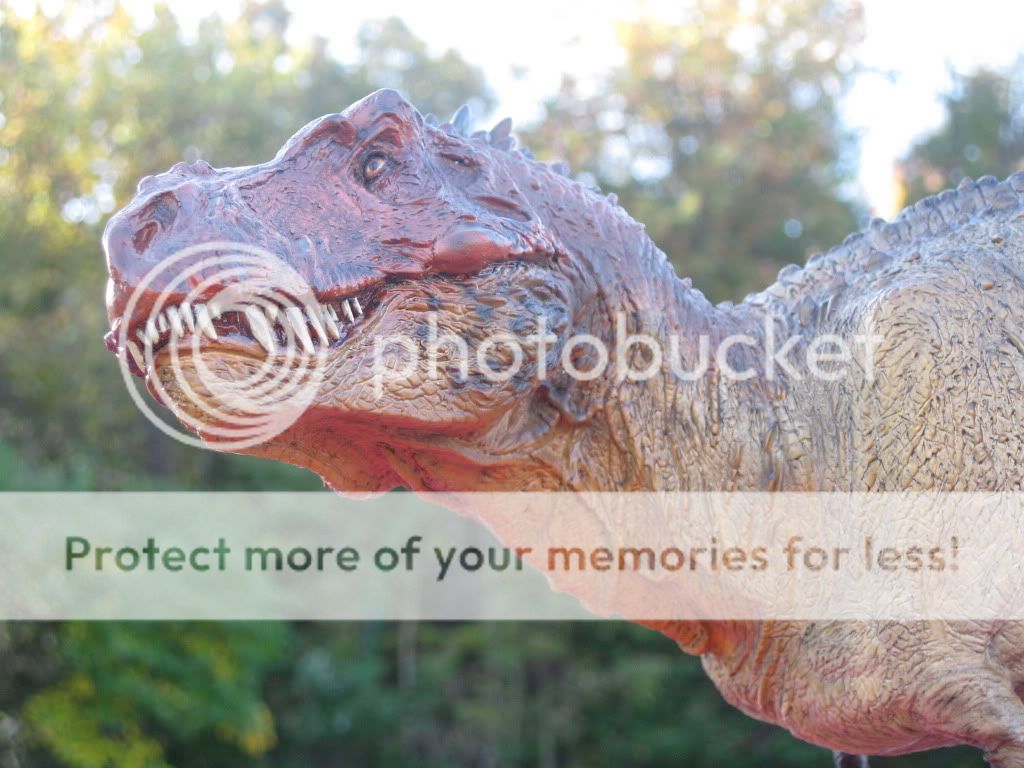
Throughout the history of man's love affair with dinosaurs, Tyrannosaurus rex has inarguably enjoyed the most immense popularity and familiarity. Whenever a new theropod is discovered today, one is quick to notice that T.rex is unfailingly used as the standard of comparison for whichever new beast enters paleontological knowledge. However large and imposing, no prehistoric beast has succeeded in stealing the limelight from T.rex in the public consciousness. The Tyrant Lizard King has set the bar for fearsomeness, the living embodiment of carnivorous might to tread upon our world. Whenever a line of dinosaur collectibles is introduced, it seems compulsory to produce an interpretation of T.rex. Sideshow collectibles has given us two stunning renditions of his royal highness... notice I used the plural "renditions", added testament to the awe inspired by this animal.
In the diorama, we have T.rex coupled with its timeless foe, Triceratops, though not in the manner we were expecting. T.rex isn't the triumphant combatant in the diorama, he's a neophyte, a young buck literally biting off far more than he can chew with a T.horridus bull who is no stranger to attacking Tyrannosaurs. The result is two beasts entangled in a dance of death, both animals plummeting down a cliffside in a prehistoric yin yang of violence which will culminate in both of their deaths. Here we have a young T.rex, never having realized its full potential, and we see it captured in the statue only moments before its death.
THAT was a different take on T.rex, something the public wasn't used to seeing. Sideshow discovered the answer to the question, "How do you make an animal so very familiar appear both new and interesting?" The diorama showed us one answer to that question, and if there was any lingering doubt that Sideshow achieved said goal, the maquette truly staid all naysayers in their tracks. The Tyrannosaurus rex in the maquette is not a subadult, ignorant of the dangers of the world. On the contrary, he is the alpha predator of his time, the absolute zenith of tyrannosaurid evolution and achievement...
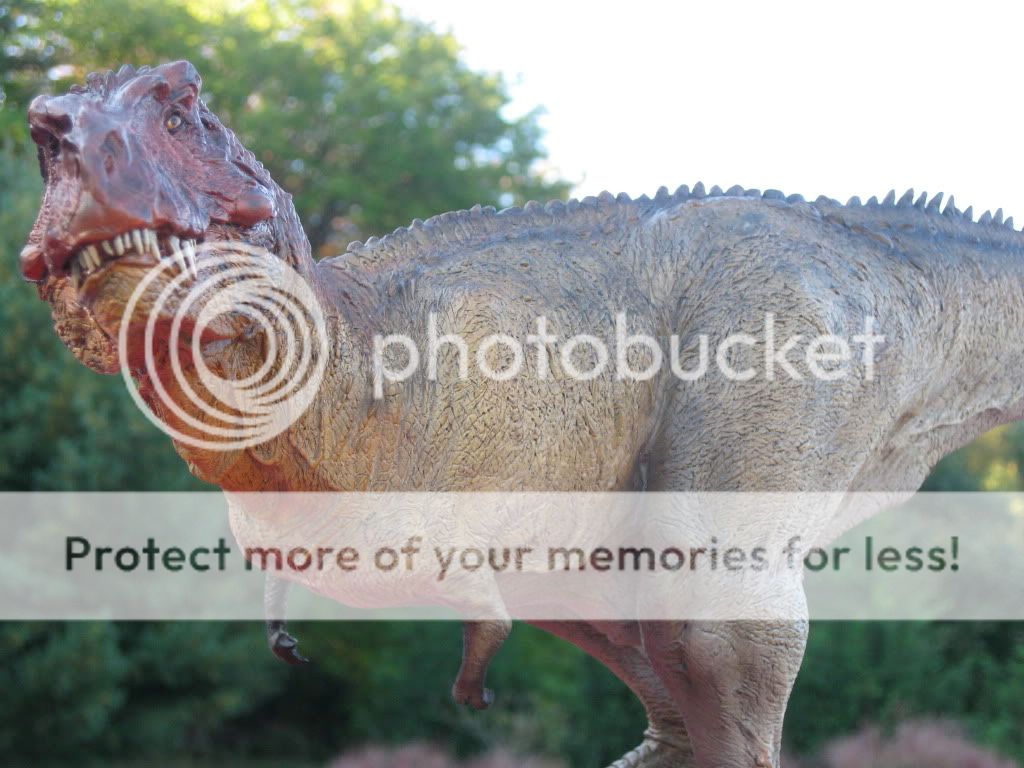

I'll start with the choice of base. Sideshow elected to use detritus, fallen trees, and algal growth to accentuate the atmosphere, to make us believe that the prehistoric beast upon which we gaze mirrors in its life the environment it has selected as its territory. An ancient forrest inhabited by an ancient predator. It's a small leap of imagination to mentally envision nervous groups of herbivores passing the forest on their migratory trek, ever looking for a carnivore almost mythic to them in reputation and villainy; adults begin to cluster their young toward the center of the herd, sentries flank the group to warn, fight, or sacrifice themselves to further the survival of the group. All of this simply inspired by gazing upon the terrain in which lurks the Tyrant of Hell Creek.
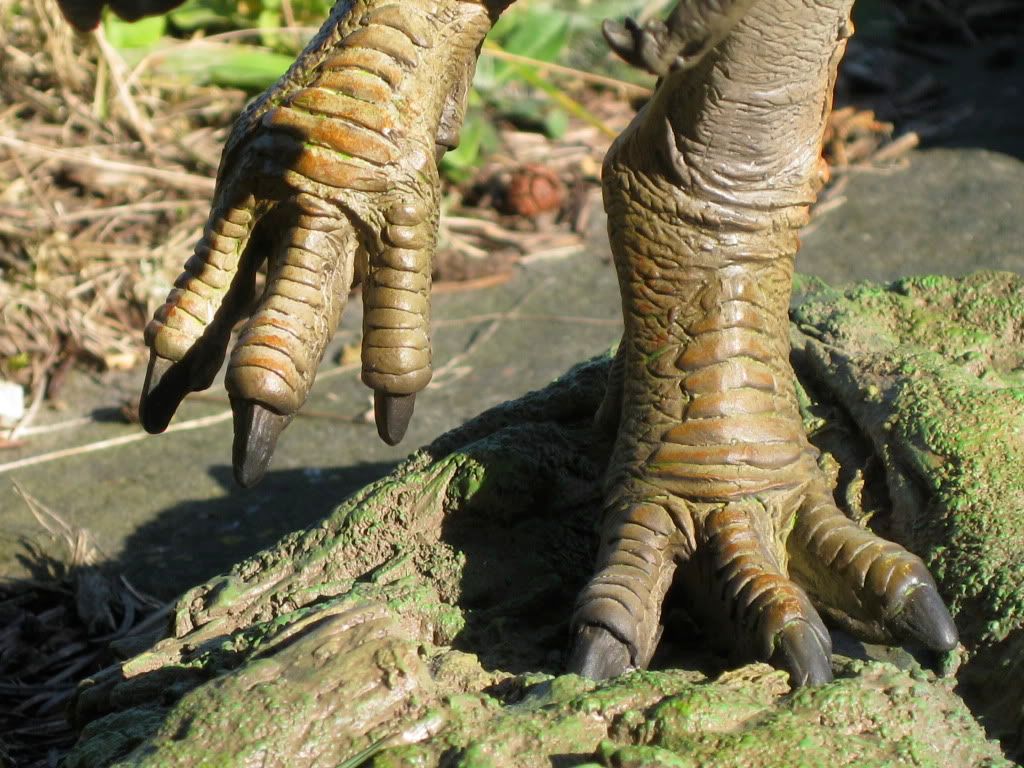
Like many have already stated, I too had trouble fitting the peg on the left leg into the base. A little patience, however, goes a long way, and in under a few minutes the statue stands securely in place. Yes, it was frustrating, and I had to act with measured delicacy and persistence, hoping not to damage the Dinosauria piece for which I have had the highest of expectations. For that reason, assembling the piece was a tad frustrating, but ultimately rewarding.
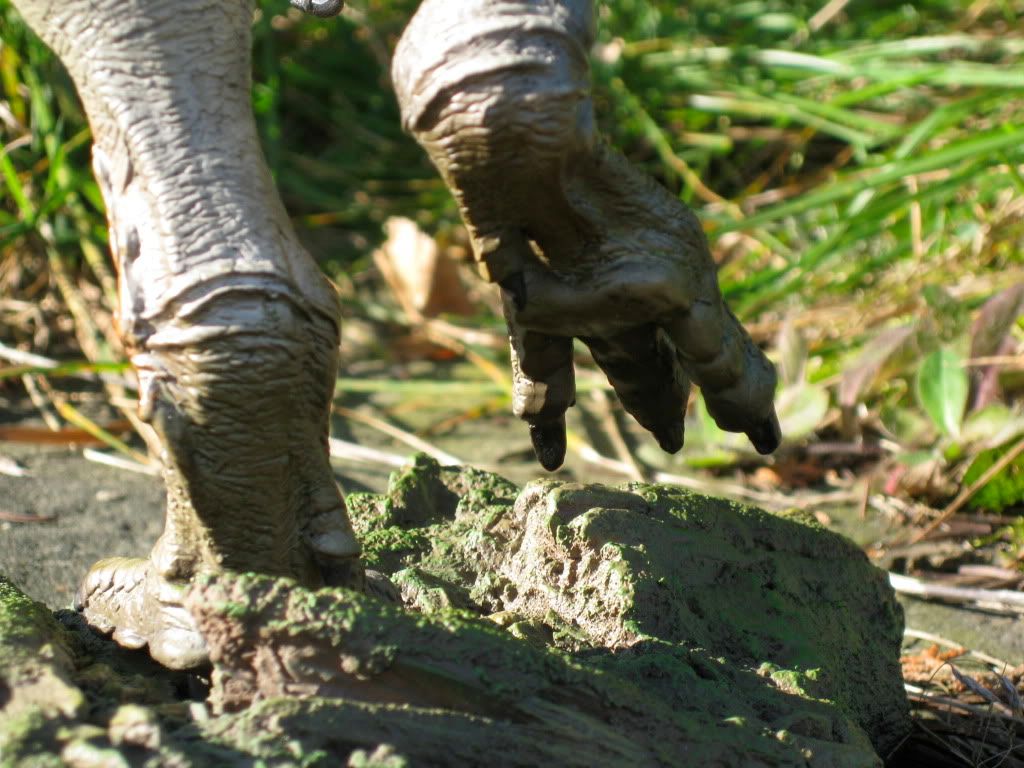
Now to the T.rex itself. I have never personally beheld any statue which conveys so very much about the individual animal more so than this maquette. The backstory for the statue relays that the Tyrant of Hell Creek is depicted in mid-stride, turning to meet a much younger and ultimately inexperienced combatant. This is where I'll begin to assert how much the personality of the animal leaps forth from the sculpt upon close examination; He seems as if he has been cruelly interrupted while patrolling his territory, deviating from his course to discipline an impudent whelp intruding within his domain. Just look at those eyes! Now, I imagine if the eyes aren't painted evenly this exercise may be a bit comical, but on my maquette, they are evenly placed; the right eye widened, and the left eye squinting. The expression looks to be one of both confusion and rage. The T.rex is furious at this effrontery, letting loose a deep growl and turning to assert his dominance as he has so very many times before.
I have never personally beheld any statue which conveys so very much about the individual animal more so than this maquette. The backstory for the statue relays that the Tyrant of Hell Creek is depicted in mid-stride, turning to meet a much younger and ultimately inexperienced combatant. This is where I'll begin to assert how much the personality of the animal leaps forth from the sculpt upon close examination; He seems as if he has been cruelly interrupted while patrolling his territory, deviating from his course to discipline an impudent whelp intruding within his domain. Just look at those eyes! Now, I imagine if the eyes aren't painted evenly this exercise may be a bit comical, but on my maquette, they are evenly placed; the right eye widened, and the left eye squinting. The expression looks to be one of both confusion and rage. The T.rex is furious at this effrontery, letting loose a deep growl and turning to assert his dominance as he has so very many times before.
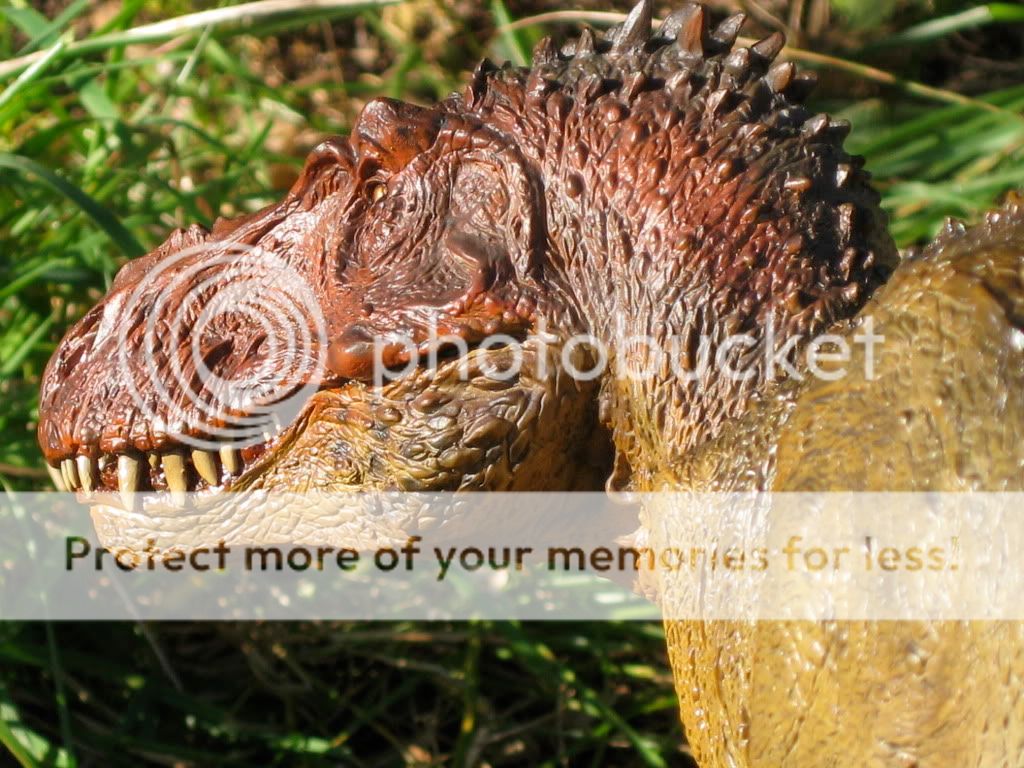
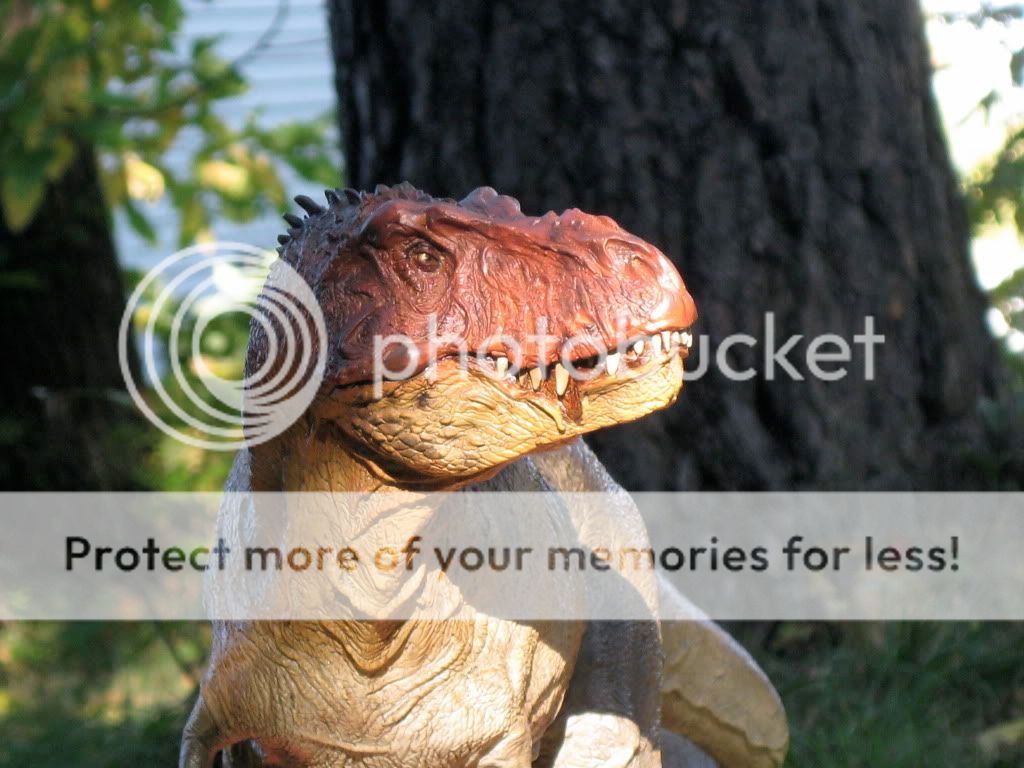
The piece is clearly collaborative. David Krentz's signature dynamism is present. The posture is that of an active animal, not sedentary but on the move, gliding through the woods he stalks like a specter, haunting not only this forrest but the minds of all dinosaurs that have had the misfortune to meet him, and the good fortune count themselves among the survivors of such encounters. The tail itself flourishes much like a signature, and rightfully so since it is a signature of David Krentz's work, seen in Tyrannosaurs in "Krentz Presentz!" and Gorgosaurus Judith to name only a few.
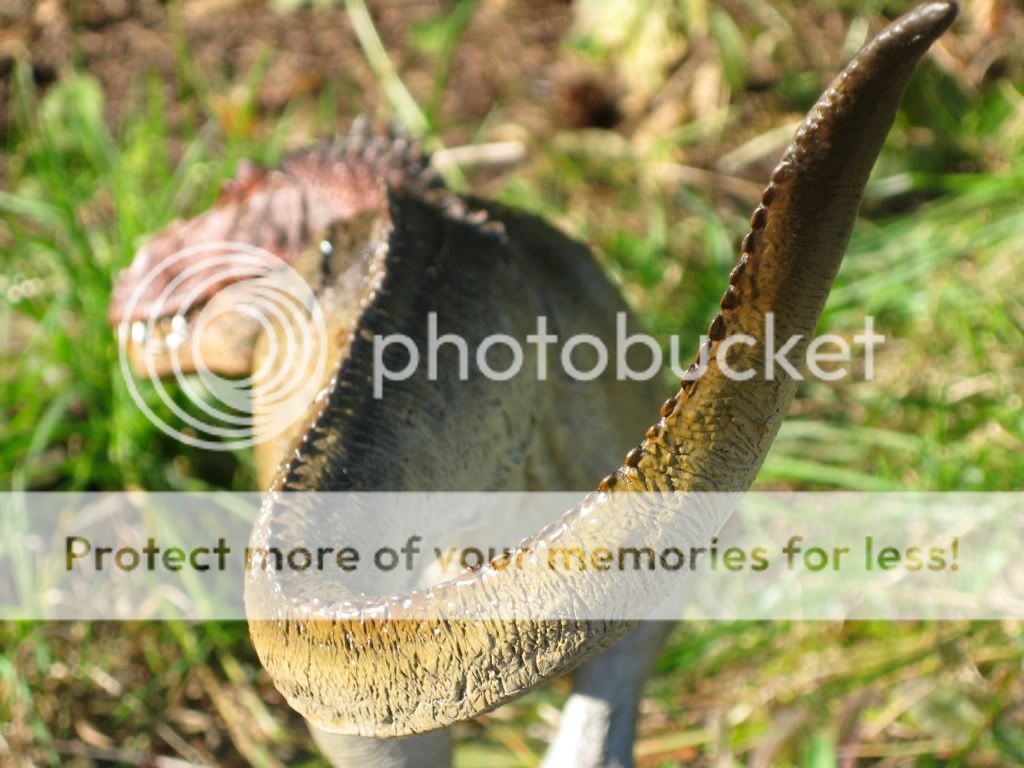
Dinosauria Review #3: Tyrannosaurus rex maquette
Part I
I'm posting this review in parts because I wish to post more than the allowed number of photos per post.

Throughout the history of man's love affair with dinosaurs, Tyrannosaurus rex has inarguably enjoyed the most immense popularity and familiarity. Whenever a new theropod is discovered today, one is quick to notice that T.rex is unfailingly used as the standard of comparison for whichever new beast enters paleontological knowledge. However large and imposing, no prehistoric beast has succeeded in stealing the limelight from T.rex in the public consciousness. The Tyrant Lizard King has set the bar for fearsomeness, the living embodiment of carnivorous might to tread upon our world. Whenever a line of dinosaur collectibles is introduced, it seems compulsory to produce an interpretation of T.rex. Sideshow collectibles has given us two stunning renditions of his royal highness... notice I used the plural "renditions", added testament to the awe inspired by this animal.
In the diorama, we have T.rex coupled with its timeless foe, Triceratops, though not in the manner we were expecting. T.rex isn't the triumphant combatant in the diorama, he's a neophyte, a young buck literally biting off far more than he can chew with a T.horridus bull who is no stranger to attacking Tyrannosaurs. The result is two beasts entangled in a dance of death, both animals plummeting down a cliffside in a prehistoric yin yang of violence which will culminate in both of their deaths. Here we have a young T.rex, never having realized its full potential, and we see it captured in the statue only moments before its death.
THAT was a different take on T.rex, something the public wasn't used to seeing. Sideshow discovered the answer to the question, "How do you make an animal so very familiar appear both new and interesting?" The diorama showed us one answer to that question, and if there was any lingering doubt that Sideshow achieved said goal, the maquette truly staid all naysayers in their tracks. The Tyrannosaurus rex in the maquette is not a subadult, ignorant of the dangers of the world. On the contrary, he is the alpha predator of his time, the absolute zenith of tyrannosaurid evolution and achievement...


I'll start with the choice of base. Sideshow elected to use detritus, fallen trees, and algal growth to accentuate the atmosphere, to make us believe that the prehistoric beast upon which we gaze mirrors in its life the environment it has selected as its territory. An ancient forrest inhabited by an ancient predator. It's a small leap of imagination to mentally envision nervous groups of herbivores passing the forest on their migratory trek, ever looking for a carnivore almost mythic to them in reputation and villainy; adults begin to cluster their young toward the center of the herd, sentries flank the group to warn, fight, or sacrifice themselves to further the survival of the group. All of this simply inspired by gazing upon the terrain in which lurks the Tyrant of Hell Creek.

Like many have already stated, I too had trouble fitting the peg on the left leg into the base. A little patience, however, goes a long way, and in under a few minutes the statue stands securely in place. Yes, it was frustrating, and I had to act with measured delicacy and persistence, hoping not to damage the Dinosauria piece for which I have had the highest of expectations. For that reason, assembling the piece was a tad frustrating, but ultimately rewarding.

Now to the T.rex itself.


The piece is clearly collaborative. David Krentz's signature dynamism is present. The posture is that of an active animal, not sedentary but on the move, gliding through the woods he stalks like a specter, haunting not only this forrest but the minds of all dinosaurs that have had the misfortune to meet him, and the good fortune count themselves among the survivors of such encounters. The tail itself flourishes much like a signature, and rightfully so since it is a signature of David Krentz's work, seen in Tyrannosaurs in "Krentz Presentz!" and Gorgosaurus Judith to name only a few.

Scar
Super Freak
Dinosauria Review #3: Tyrannosaurus rex maquette
Part II
The tail sways in a ghost-like manner, almost like the lash of an oppressor. This leads me to the dominant, martial aspect of the animal. The age of the animal belies that every moment of its life has revolved around combat. In Tyrannosaurs we traditionally see two forms - the gracile and robust forms. Formerly we used to believe these were sexually dimorphic characters, but in recent years a glut of evidence points to it being likely correlated to age rather than sex. And the age and anatomical characteristics of this creature clearly display that it is the robust form of T.rex along the lines of RSM 2523.8 or FMNH PR2081 - the size of the skull in comparison to the rest of the body, bowed forelimbs, and emphasized again by space-consuming yet elegant tail. We are literally looking at a hardened combatant. Its very body looks to be armor. Dermal protuberances line the entire dorsal region, not only along the spine itself, but even edging the upper thighs. These protrusions are most noticeable along the cervical region posterior to the skull; while ornamental, their angular nature even in display evokes menace. The orbital ridges are thick and heavily ossified, again a characteristic of the robust form of Tyrannosaurs, a characteristic which Bakker hypothesized could have been used in conspecific combat, along with the nasal ridge which is likewise thickened - even to such an extent that it elevates from above the base and extends over the naris. This prominence in terms of the nasal ridge is likely from the bone disease that this individual has running throughout its body, but that makes it no less formidable.


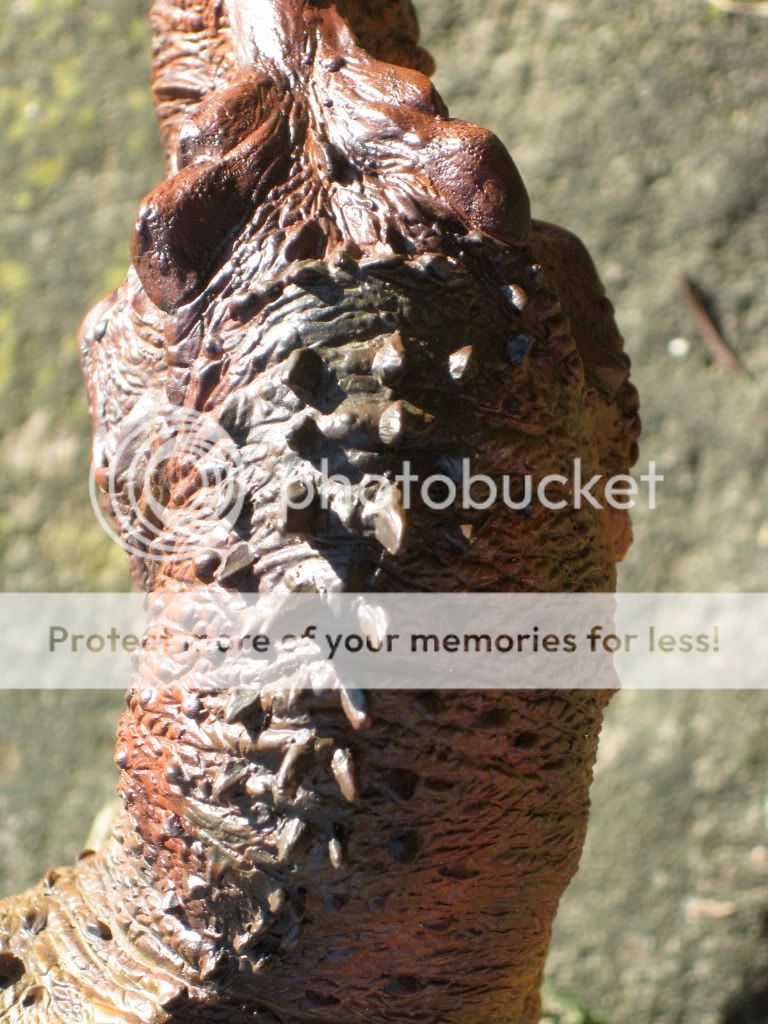
Now to the scars. Every injury, every etch in its hide, tells a story. The story of this animal's life is etched into its very flesh. Trophies, medals of valor, this animal's rewards for contests wherein it emerged the victor. Some members of this forum have been complaining about the detailing on the scars. When reading their comments, I find myself wondering if any of them have ever actually seen avulsion injuries on large reptiles. My guess is no, because then none of this complaining would have ensued. No two scars on an individual should be alike. Those along the right flank of the thoracic region as well as along the right hip are clearly older, with the tissue having build up over time, elevating over the cutaneous surface.
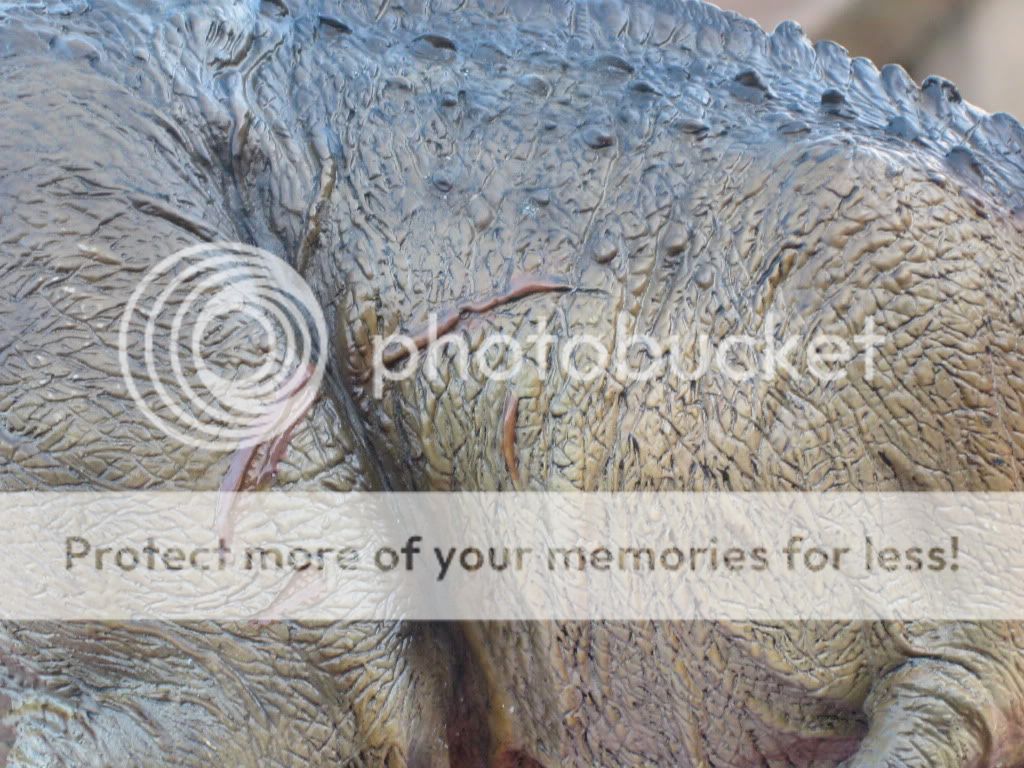
Conversely, the immense area on the tail where it appears the skin and a decent portion of subcutaneous tissue was removed, isn't elevated, but still deeper than the surface tissue, glistening giving the impression that it is relatively fresh (over the past several weeks or months) and is slowly healing.
Now to the scarring all throughout the skull. The left side of the skull has flaps of skin and scales that have healed over, still facing perpendicular to the body surface. The right side of the skull, however, makes these injuries appear to have been the tender touch of a lover by comparison. The raking wounds along the right side of the skull are a painful reminder of perhaps the most impressive combative success of this alpha male's career - battling off a pack of Tyrannosaurs and in particular its aggressive matriarch. While some of the wounds from this attack seem to have healed over, others are rich with fluid. It seems as if every time this T.rex flexes its jaw it opens these wounds again, even if only slightly in comparison to when they were originally inflicted. The maxilla sports several gruesome sections, and the mandible has an immense section of flesh torn away. What's nice is looking at this in comparison to the rest of the jaw. Displaying not only its ferocity, but its age, this T.rex has slackened skin along its lower jaw, revealing the deep crimson gums beneath. I found it interesting to compare this loose skin along the left side of the mandible with the same section on the right side, where we can see that the matriarch's teeth found purchase in this skin and tore it free from its foundations.

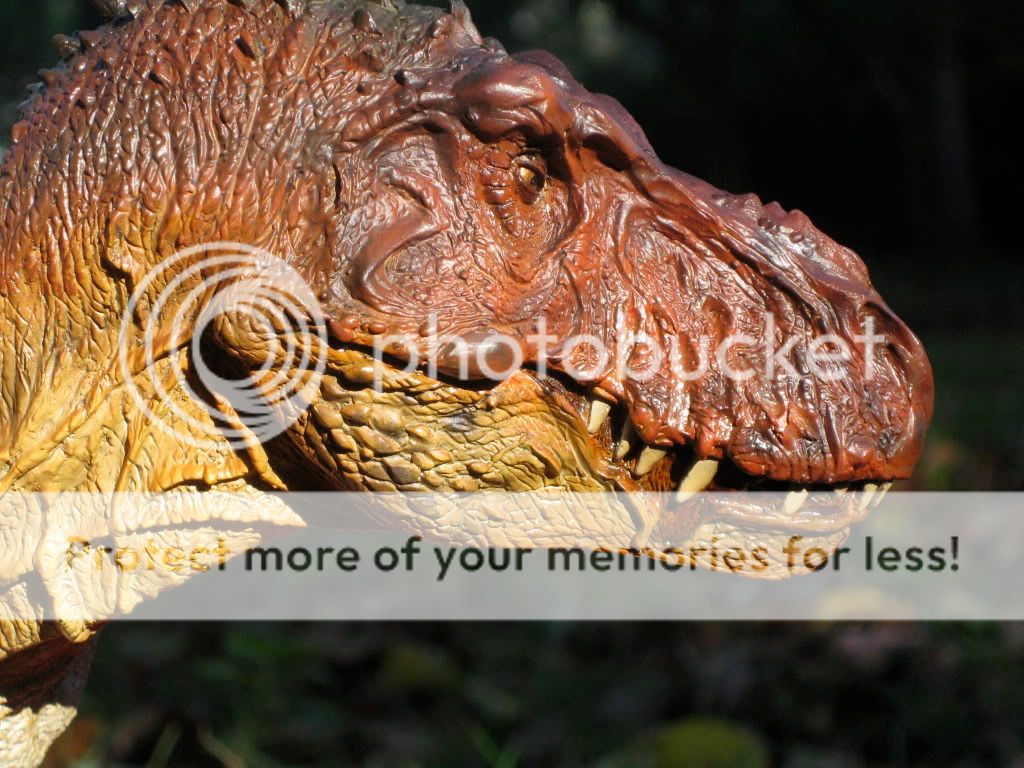
Now obviously when looking to this particular section of the creature, one in drawn to its teeth. I personally like the idea of the T.rex being depicted with its jaws clamped shut rather than splayed with ferocity. It would be like every piece of wildlife art depicting lions having them roaring and striking out with their claws. Lions are not in a constant state of attack, and sometimes the moment before launching the attack is where the artist can find the most menace in the predator. That feat was achieved here. Speaking as someone who looks at animal dentition every single day, the buildup of plaque as the teeth move proximally is extraordinary. The way in which the paint and gloss were applied make the teeth appear to be genuine and far more than simple polystone. Also, the teeth are not uniform. So many people have the misconception that T.rex teeth are generally homodont and vary only in size. On the contrary, T.rex possessed heterodont dentition, meaning that its teeth varied widely in their design and purpose, depending upon where they were placed in the jaw. The large teeth along the side show those tools which were meant to drive through bone as if it were margarine, and opposite these we see the delicate nipping teeth in the front which would have been equally useful in peeling away bits of flesh as well as grooming.
And now to the color scheme. Anthony Mestas did an exemplary job here, and in natural light one can see the intricate interplay of colors to execute a magnificent cryptic coloration. The tan, green, grey, and brown shades which result give the animal exceptional cover for patrolling dense foliage, but the head itself is quite impressive. The shade of red isn't overwhelming, thankfully. Like the rest of the body on this geriatric autocrat, the colors are somewhat muted, thought still attain a vibrancy that is quite beautiful. In countless bird and reptile species we see these features. Males birds develop more vibrant coloration depending upon the season and dominance of the individuals; male reptiles flush capillary beds in order to intimidate or impress. This male seems to be literally "red with anger" over the presence of a rival Tyrannosaur in his territory, and it's a fine touch of realism in the piece. Speaking of realism, the gloss is applied quite well throughout. I mentioned the fresher scars sporting such coating, but the eyes and the nostrils appear moist, another of the many features which truly makes the maquette come alive.
In short, it's my favorite piece in the collection thus far. I could pore over the minutia of details for hours on end. The line continues to impress. Even the exclusive skull had an interplay of colors that was impressive, and the delicate sculpting of the teeth to appear as sharp as they are thick leaves no need to wonder to which beast this skull belongs.

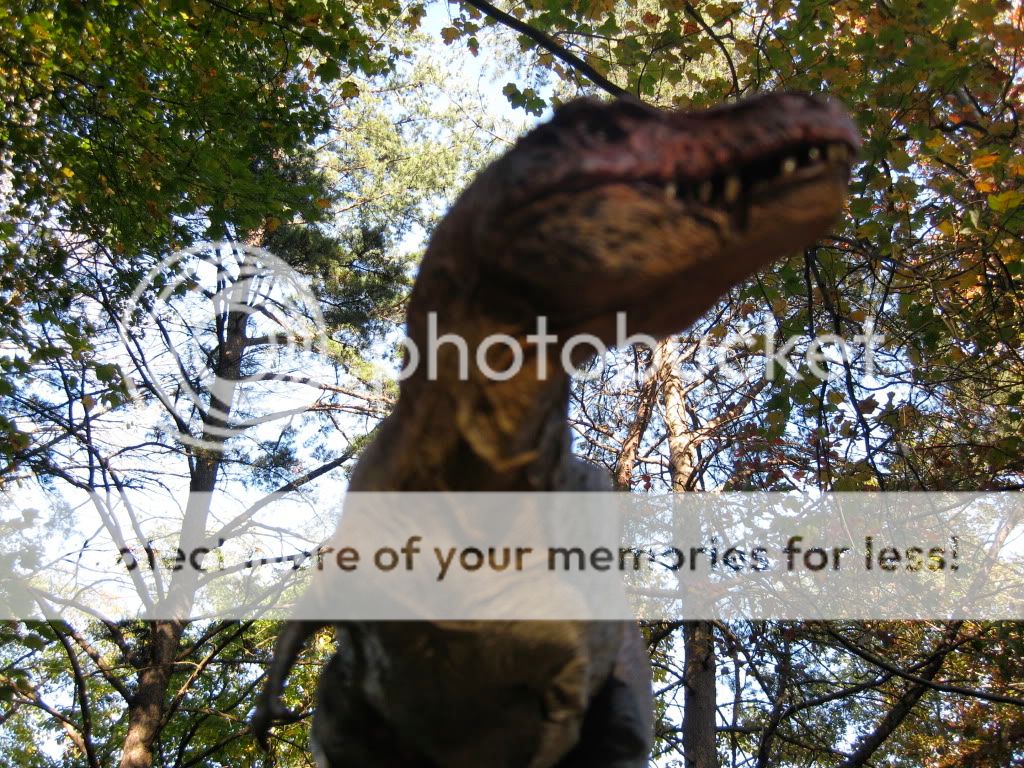
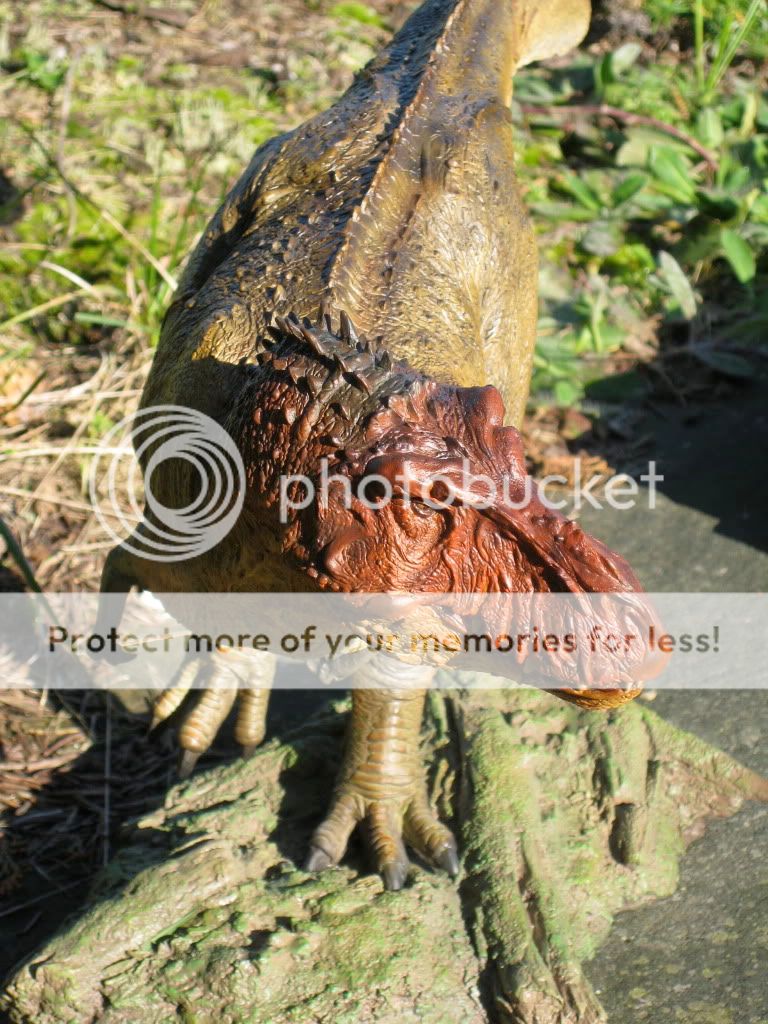
Part II
The tail sways in a ghost-like manner, almost like the lash of an oppressor. This leads me to the dominant, martial aspect of the animal. The age of the animal belies that every moment of its life has revolved around combat. In Tyrannosaurs we traditionally see two forms - the gracile and robust forms. Formerly we used to believe these were sexually dimorphic characters, but in recent years a glut of evidence points to it being likely correlated to age rather than sex. And the age and anatomical characteristics of this creature clearly display that it is the robust form of T.rex along the lines of RSM 2523.8 or FMNH PR2081 - the size of the skull in comparison to the rest of the body, bowed forelimbs, and emphasized again by space-consuming yet elegant tail. We are literally looking at a hardened combatant. Its very body looks to be armor. Dermal protuberances line the entire dorsal region, not only along the spine itself, but even edging the upper thighs. These protrusions are most noticeable along the cervical region posterior to the skull; while ornamental, their angular nature even in display evokes menace. The orbital ridges are thick and heavily ossified, again a characteristic of the robust form of Tyrannosaurs, a characteristic which Bakker hypothesized could have been used in conspecific combat, along with the nasal ridge which is likewise thickened - even to such an extent that it elevates from above the base and extends over the naris. This prominence in terms of the nasal ridge is likely from the bone disease that this individual has running throughout its body, but that makes it no less formidable.



Now to the scars. Every injury, every etch in its hide, tells a story. The story of this animal's life is etched into its very flesh. Trophies, medals of valor, this animal's rewards for contests wherein it emerged the victor. Some members of this forum have been complaining about the detailing on the scars. When reading their comments, I find myself wondering if any of them have ever actually seen avulsion injuries on large reptiles. My guess is no, because then none of this complaining would have ensued. No two scars on an individual should be alike. Those along the right flank of the thoracic region as well as along the right hip are clearly older, with the tissue having build up over time, elevating over the cutaneous surface.

Conversely, the immense area on the tail where it appears the skin and a decent portion of subcutaneous tissue was removed, isn't elevated, but still deeper than the surface tissue, glistening giving the impression that it is relatively fresh (over the past several weeks or months) and is slowly healing.
Now to the scarring all throughout the skull. The left side of the skull has flaps of skin and scales that have healed over, still facing perpendicular to the body surface. The right side of the skull, however, makes these injuries appear to have been the tender touch of a lover by comparison. The raking wounds along the right side of the skull are a painful reminder of perhaps the most impressive combative success of this alpha male's career - battling off a pack of Tyrannosaurs and in particular its aggressive matriarch. While some of the wounds from this attack seem to have healed over, others are rich with fluid. It seems as if every time this T.rex flexes its jaw it opens these wounds again, even if only slightly in comparison to when they were originally inflicted. The maxilla sports several gruesome sections, and the mandible has an immense section of flesh torn away. What's nice is looking at this in comparison to the rest of the jaw. Displaying not only its ferocity, but its age, this T.rex has slackened skin along its lower jaw, revealing the deep crimson gums beneath. I found it interesting to compare this loose skin along the left side of the mandible with the same section on the right side, where we can see that the matriarch's teeth found purchase in this skin and tore it free from its foundations.


Now obviously when looking to this particular section of the creature, one in drawn to its teeth. I personally like the idea of the T.rex being depicted with its jaws clamped shut rather than splayed with ferocity. It would be like every piece of wildlife art depicting lions having them roaring and striking out with their claws. Lions are not in a constant state of attack, and sometimes the moment before launching the attack is where the artist can find the most menace in the predator. That feat was achieved here. Speaking as someone who looks at animal dentition every single day, the buildup of plaque as the teeth move proximally is extraordinary. The way in which the paint and gloss were applied make the teeth appear to be genuine and far more than simple polystone. Also, the teeth are not uniform. So many people have the misconception that T.rex teeth are generally homodont and vary only in size. On the contrary, T.rex possessed heterodont dentition, meaning that its teeth varied widely in their design and purpose, depending upon where they were placed in the jaw. The large teeth along the side show those tools which were meant to drive through bone as if it were margarine, and opposite these we see the delicate nipping teeth in the front which would have been equally useful in peeling away bits of flesh as well as grooming.
And now to the color scheme. Anthony Mestas did an exemplary job here, and in natural light one can see the intricate interplay of colors to execute a magnificent cryptic coloration. The tan, green, grey, and brown shades which result give the animal exceptional cover for patrolling dense foliage, but the head itself is quite impressive. The shade of red isn't overwhelming, thankfully. Like the rest of the body on this geriatric autocrat, the colors are somewhat muted, thought still attain a vibrancy that is quite beautiful. In countless bird and reptile species we see these features. Males birds develop more vibrant coloration depending upon the season and dominance of the individuals; male reptiles flush capillary beds in order to intimidate or impress. This male seems to be literally "red with anger" over the presence of a rival Tyrannosaur in his territory, and it's a fine touch of realism in the piece. Speaking of realism, the gloss is applied quite well throughout. I mentioned the fresher scars sporting such coating, but the eyes and the nostrils appear moist, another of the many features which truly makes the maquette come alive.
In short, it's my favorite piece in the collection thus far. I could pore over the minutia of details for hours on end. The line continues to impress. Even the exclusive skull had an interplay of colors that was impressive, and the delicate sculpting of the teeth to appear as sharp as they are thick leaves no need to wonder to which beast this skull belongs.



Similar threads
- Replies
- 4
- Views
- 2K
- Replies
- 28
- Views
- 6K
- Replies
- 10
- Views
- 6K
- Replies
- 30
- Views
- 4K





